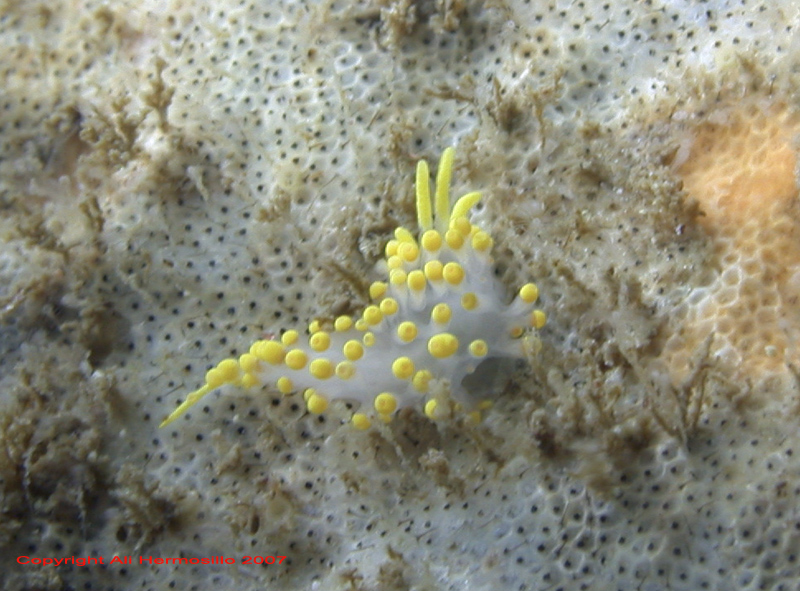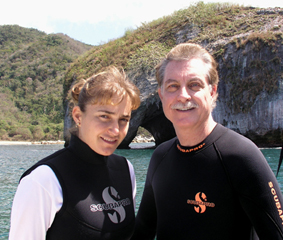 |
Cuthona behrensi
Photo courtesy of Ali HermosilloSpecimen collected and photographed at Los Arcos, Bahia de Banderas, Jalisco-Nayarit, Mexico,
May 2004
Cuthona behrensi , Hermosillo and Valdes, 2007
It is always great to finally give names to all those "sp." in our texts, books and web sites. This week´s critter was published in a very special paper, since it contains 5 species of aeolids that Angel Valdes and I named in recognition of dear friends, coleagues and family. (See Reference below).
The one in this week´s BOW is Cuthona behrensi. (Cuthona sp. 9 in Yolanda, Angel and Terry´s central America book). It is very distinct from any other Cuthona because of its coloration: two colors, bright white and yellow. I collected this species during an expedition on board the RV Urraca from the STRI (Smithsonian Tropical Research Institute) in Panama. I was invited by Dr. Ross Robertson , a fish expert (for all of you out there, fish are those fast swimming things that get in the way of your slug shots) for a biodiversity project in the National Park of Coiba.
Back then (2003), I found 75 species of opisthobranchs and during a later visit, Yolanda Camacho and I published a note adding seven more species to the list.
Since I was there, the hard work of Dr. Todd Capson, Dr. Alicia Ibañez, Dr. Ross Robertson, Dr. Hector Guzman, Mr. Joe Pigozzi and other STRI researchers resulted in the inclusion of Parque Nacional de Coiba in UNESCO World Heritage Status in 2005.
The following is being quoted from the original publication. For those of you that are interested in obtaining a PDF version of the paper, please contact myself, Angel, or Dave directly.
"... The generic placement of Cuthona behrensi is based on the external morphology and anatomy of this species, which fit within the diagnosis of the genus by Gosliner (1981). Externally, Cutona behrensi is very different from other known species of Cuthona . There is no other species in this genus with only two colors that has a geographic range that overlaps the known occurrence of C. behrensi . Moreover, no other species of Cuthona is currently known from Panama. Among the species of Cuthona described for the eastern Pacific, Cuthona cocoachroma Williams and Gosliner, 1979 also has two colors, but it has a brown-tinted white background with brown cerata; the cerata bear bright white tips (Williams and Gosliner 1979). The shape of the body is also different from that of Cuthona behrensi, being more slender with narrower cerata, as opposed to the stouter C. behrensi with inflated cerata.
Cuthona concinna (Alder and Hancock, 1843) is found in the eastern Pacific (Vancouver, Canada) and in the North Atlantic (see Behrens 1991). This species has a white background color similar to that of Cuthona behrensi, but it is easily distinguishable by the presence of its brown color and the more slender shape of the cerata. Moreover, the rhinophores of C. concinna are thick at the bases and taper abruptly into pointed apices (Behrens 1991), whereas the rhinophores of C. behrensi do not taper and the apices are rounded.
Cuthona divae (Er. Marcus, 1961) is known for the northern Pacific coast of the United States (see Behrens 1991). The body is white as are the rhinophores and the oral tentacles. The dark pink digestive gland can be seen through the translucent white cerata (Marcus 1961)...."
Reference :
Five new species of aeolid nudibranchs (Mollusca, Opisthobranchia) from the tropical eastern Pacific, Amer. Malac. Bull 22: 119-137
Puerto Vallarta, Mexico
May, 2007
WEBMASTER'S NOTES:
Still recovering from jet lag from a recent Philippines trip, I was at a loss for subject material for BOW 556! As is usually the case, the issue was resolved at three in the morning while trudging to the kitchen to make a cup of coffee. After getting the brain cells in gear, a recent publication forwarded to me by Dave was reviewed for possibilities. Yeh I know, reading branch papers at four in the morning is kinda of weird but I am already accustomed to that label since undertaking the study of branchs sometime ago. Well, lo and behold what should I find (in addition to other descriptions that will follow in weeks to come), a new cuthonid had been named for Dave. This honor follows on the heels of a Dendrodoris naming ( dendrodoris behrensi ) that was featured on the site in January.
Ali Hermosillo was gracious enough on short notice to make this BOW possible and the rest is history! Kudos are definitely in order for Ali!
The honor is richly deserved in recognition of Dave's dedication
to the science of sea slugs not only through book publication but also his committed support from day one of the slug site without which we would have been out of business some time ago.
San Diego, Calif
May, 2007
March 2005

Ali Hermosillo and Dave Behrens
Author:
Pacific Coast Nudibranchs and Nudibranch Behavior
Send Dave mail at dave@seachallengers.com |
